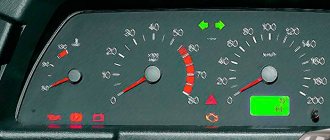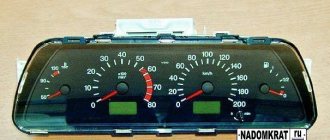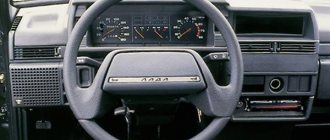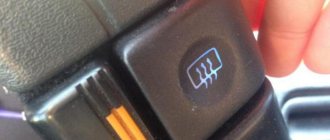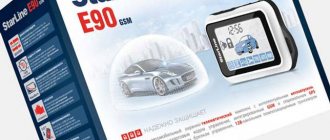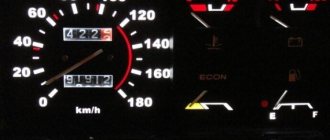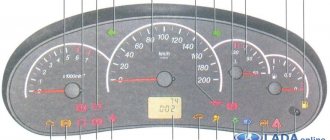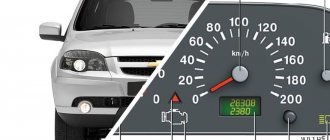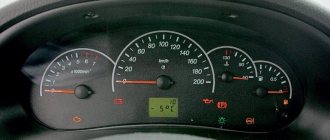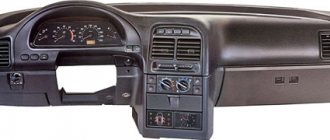The meaning of the indication on the instrument panel of the VAZ 2109
On VAZ 2108 2109 21099 cars there are three options for the instrument panel: 1) Low instrument panel. 2) High instrument panel. 3) Euro instrument panel. The instrument panel is the organ of interaction between the car and the driver. With its help, the driver knows information about the state of all components of the car. That is, the driver receives all the information by looking at the icons and instruments on the instrument panel. Especially novice drivers need to know and understand the instrument panel display. So, the very first, and probably the most popular option for the instrument panel is a low instrument panel.
Low instrument panel
1a - speedometer, to indicate the speed of the vehicle. 2a - coolant temperature indicator. Designed to display engine temperature. The driver must control the engine temperature to prevent overheating. 3a - voltmeter - indication of on-board network voltage. The problem with the low panel is that the voltmeter needle very often twitches along with the direction indicators. This happens due to a voltage drop in the wires from the battery to the mounting block. 4a - fuel level indicator, for monitoring the fuel level in the tank by the driver of the car. 5a - the indicator lamp for the reserve fuel balance begins to blink first and then light up when there are three liters of fuel left in the tank. 6a - econometer - shows the vacuum in the engine input manifold. If you drive when the needle is not in the yellow zone, you will save gas. 7a - daily mileage counter. The driver can reset this counter at his own discretion. 8a - total mileage counter. Total mileage of the vehicle. 9a - “STOP” control panel. It lights up when the car is parked with the handbrake, and also when the fuel level in the brake fluid reservoir is low. 10a - battery charge indicator lamp. If it lights up with the engine running, it means the battery is not charging. 11a - control lamp for covering the carburetor air damper. If it lights up, it means the air intake is not closed. 12a - warning lamp for turning on the hazard warning lights. 13a - warning lamp for low brake fluid level. 14a - indicator lamp for turning on the parking brake. 15a - warning lamp for emergency drop in oil pressure. One of the most important light bulbs on the VAZ instrument panel. If the light remains on while the engine is running, the engine may seize due to lack of oil. 16a - indicator lamp for turning on the direction indicators, blinks when the direction switches are on. 17a - control lamp for turning on the side lights, lights up both when the side lights are on and when the headlights are on low beam. 18a - indicator lamp for turning on the rear fog lights. Rear fog lights only work in conjunction with low beam headlights. 19a - control lamp for turning on the high beam headlights. 20a - control lamp for turning on the heated glass of the tailgate.
The high instrument panel differs from the low one in the arrangement of the light bulbs. Contains some light bulbs that are not on the low panel, as well as a tachometer.
High instrument panel
1b - speedometer, to indicate vehicle speed and mileage. 2b — handle for resetting the daily mileage counter; 3b - daily mileage counter. The driver can reset this counter at his own discretion. 4b - total mileage counter. 5b - fuel level indicator, for monitoring the fuel level in the tank by the driver of the car. 6b - light panel of the on-board control system. 7b - “TEST” display, system test when starting the car. 8b — “STOP” sign. 9b - warning lamp for failure of brake light lamps and side lights. 10b - warning lamp for low brake fluid level. If it lights up or blinks on bumps, then you need to check the brake fluid level in the reservoir. 11b - warning lamp for low coolant level; if it lights up, it means you need to add coolant to the expansion tank. 12b - indicator lamp for front brake pad wear. This lamp lights up when the sensor installed on the front brakes is working. If the light comes on, it means either the brake pads are worn out or the sensor is working falsely. In rainy weather, many people complain that this sensor responds falsely. 13b - warning lamp for level drop in the washer reservoir. If the light comes on, add washer fluid to the reservoir. 14b - warning lamp for low oil level in the engine crankcase. It is very important to understand the difference between oil level and oil pressure. This light comes on when the oil level in the engine crankcase is low. Not to be confused with the oil pressure sensor. 15b - coolant temperature indicator. Designed to display engine temperature. The driver must control the engine temperature to prevent overheating. 16b - tachometer, shows engine speed. 17b - indicator lamp for turning on the parking brake. 18b - “CHECK ENGINE” control lamp for the injection system. That is, this light bulb is intended for models with an injector. It is issued by the electronic control unit if it sees some kind of error in the electronic injection system. 19b - control lamp for covering the carburetor air damper. Indicates that the carburetor air damper is not fully open, that is, the choke is turned on. 20b - the indicator lamp for the reserve fuel balance begins to blink first and then light up when there are three liters of fuel left in the tank. 21b - warning lamp for drop in oil pressure in the engine lubrication system. Indicates that there is no oil pressure when the engine is running, which means the engine may seize. 22b - control lamp for turning on the right turn indicators, blinks when the right turn is turned on. 23b - battery charge indicator lamp; if it lights up with the engine running, it means the battery charging is not working. 24b - control lamp for turning on the left turn indicators, blinks when a left turn is turned on. 25b - warning lamp for unfastened seat belts. The seat belt buckles have sensors that turn off the light when the seat belts are fastened. 26b - warning lamp for open doors. Indication that a door is not closed operates from limit switches that operate on the door. 27b - indicator lamp for turning on the side lights, lights up both with side lights and low beam headlights. 28b - control lamp for turning on the high beam headlights; 29b - “CHECK ENGINE” warning lamp (“Check engine”) of the toxicity reduction system.
Instrument cluster on the VAZ euro panel:
Euro dashboard
1c - coolant temperature indicator. Designed to display engine temperature. The driver must control the engine temperature to prevent overheating. 2c - tachometer, shows engine speed. 3c - the left turn signal indicator lamp blinks when a left turn is turned on. 4c - the right turn signal indicator lamp blinks when the right turn is turned on. 5c - speedometer, to indicate the speed of the vehicle. 6c - fuel level indicator, for monitoring the fuel level in the tank by the driver of the car. 7v - fuel reserve warning lamp. 8v - fuel reserve warning lamp. 9v - warning lamp for emergency condition of the brake system. 10v - control lamp for turning on the high beam headlights. 11c — reset button for the daily mileage indicator. 12v - mileage indicator. 13v - warning lamp for turning on the hazard warning lights. 14v — control lamp “CHECK ENGINE” (“Check engine”); 15v — indicator of time and temperature outside; 16v - battery charge indicator lamp; if it lights up with the engine running, it means the battery is not charging. The generator needs to be checked. 17v - indicator lamp for turning on the parking brake. 18v - indicator lamp for insufficient oil pressure, shows that when the engine is running there is no oil pressure, that is, the engine may seize. 19v - carburetor air damper control lamp (reserve for a car with a fuel injection system). That is, if the car has an injection system, then this light will not work, since it is for carburetor models.
Fuel level sensor
Especially for those car owners who want to see accurate data and are looking for a suitable type of sensor, we offer a table for your reference:
The optimal choice would be the sensor number 2108-3827010-01. Its reading is approximately as follows: the middle of the scale indicates a level of 20 liters, and the red zone begins when the tank contains about 5 liters of fuel.
In any case, when you buy a sensor, test it for resistance: the best option for you is a sensor that shows 360 ohms when the tank is empty.
Video review of the dashboard on the VAZ-2109:
For your convenience, we have various methods of delivery and payment for goods:
Order of shipment to regions of the Russian Federation.
- Place an order through the website or by phone.
- The manager contacts you by phone and clarifies the order details and payment method.
- You pay the bill through the bank, after the money arrives in our bank account (usually 1-3 days after payment for the goods), when paying through electronic money systems (funds are credited within a day), we deliver the goods to the transport company.
Payment Methods:
1. Payment via SberBank Visa card. 2. Payment on Yandex.Money 3. Payment on QIWI 4. Payment to a current account 5. Cash on delivery - Payment upon receipt at the post office (Only for delivery by Russian Post)
1. Russian Post Calculation of delivery costs (city of departure Togliatti) Tracking the parcel by track number Delivery time from 3 to 12 days, throughout Russia.
2. Russian Post courier service EMS Calculation of delivery costs (city of departure Togliatti) Tracking the parcel by track number
Delivery time from 4 to 10 days, throughout Russia, is 100% more expensive than by mail.
3. First class Russian Post.
Delivery time from 3 to 10 days, throughout Russia, is 50% more expensive than by mail.
4. Transport class=”aligncenter” width=”655″ height=”337″[/img] (Pack, Kit, Business Lines, Baikal Service, Autorating, Energy, ZhelDorExpedition).
Delivery time is up to 10 days, throughout Russia, only to large cities. Oversized parcels are 50% more profitable than by mail.
5. Delivery by courier in Tolyatti
Delivery time from 1 hour to 12 in Tolyatti. The cost is 100-150 rubles depending on the area.
6.Pickup from the online store office in Tolyatti. The time for self-pickup must be confirmed with the manager.
Instrument cluster
Today, VAZ 2109 cars that can be found on domestic roads, no matter whether they have carburetors or injectors, are equipped with three types of electronic devices. It can be a low panel, a high panel or a Europanel. Let's consider the description of each type separately.
"Low" panel
Low version of the control panel
Let's start with the low version. A detailed explanation of the scheme is given in the table.
| Icon | Purpose |
| 32 | Indicates which turn signal is on. The indicator stops working after the steering wheel is turned. |
| 33 | A light lamp that turns on when the low beam is activated. |
| 34 | Lights up when the PTF - fog lights are turned on. |
| 35 | Lamp for turning on high beam headlights. |
| 36 | Notifies the driver that the rear window heating system is operating. |
| 37 | A signal alerting the motorist to the need to stop and repair a fault. |
| 38 | Speedometer. |
| 39 | A counter that records the daily mileage of a vehicle. |
| 40 | A sensor that notifies the driver about the temperature of the antifreeze in the cooling system. |
| 41 | A sensor that records the voltage level in the vehicle's on-board network. |
| 42 | An icon that lights up when the engine fluid pressure in the system is too low. |
| 43 | hazard warning lamp. |
| 44 | The diode lights up if the brake system is in emergency condition. |
| 45 | Icon for turning on the carburetor choke or choke. |
| 46 | Engaging the handbrake. |
| 47 | This element appears when the car battery is low charged. |
| 48 | Vehicle mileage counter. |
| 49 | An ecometer whose needle rises when you press the gas pedal. |
| 50 | A line that is not recommended to be crossed - the light starts to light when the gasoline level is critically low. |
| 51 | Sensor for measuring fuel level in the tank. |
"High" panel
Instrument cluster on a high panel
Below is a high-type VAZ 2109 instrument panel with electronic backlight. Relevant for both injectors and carburetors. You will find a decoding of the circuit and combinations according to the instructions below.
| Icon | Designation |
| 42 | Speedometer, which displays the speed of the car. |
| 43 | An odometer that records the mileage of a vehicle. |
| 44 | Sensor for measuring fuel level in the tank. |
| 45 | A signal alerting the motorist to the need to stop and repair a fault. |
| 46 | Test lamp. |
| 47 | A signal alerting the motorist to the need to stop and repair a fault. |
| 48 | Lamp warning the driver about a malfunction in the operation of the signal lights. |
| 49 | A sensor that notifies the driver of a lack of antifreeze in the cooling system. |
| 50 | An indicator indicating wear of the brake pads on the front wheels. |
| 51 | The light comes on to warn the motorist about the lack of fluid in the windshield and rear window washer reservoir. |
| 52 | Indicator of lack of engine fluid pressure in the crankcase. |
| 53 | The regulator measures the antifreeze temperature level in the cooling system and displays this data on an electronic panel with backlight. |
| 54 | This icon on the high combination of the dashboard is a tachometer, demonstrating the level of engine speed of the car. |
| 55 | Additional socket. |
| 56 | A button designed to reset the daily mileage. |
| 57 | A lamp that lights up when the car's headlights are turned on. |
| 58 | Daily mileage recording sensor. |
| 59 | A diode lamp that turns on when the side lights are activated. |
| 60 | A sensor that warns the driver about an open door. |
| 61 | A lamp warning the driver that he is driving without fastened seat belts. |
| 62 | A diode indicating that the left turn signal is on. |
| 63 | This element of the combination of an electronic panel with backlight indicates the charge level in the system. |
| 64 | A diode indicating that the right turn signal is on. |
| 65 | The lamp turns on when the engine fluid pressure in the system is insufficient. |
| 66 | The diode turns on if the fuel level in the tank is critical. |
| 67 | The choke switch lamp is found only in carburetor cars. |
| 68 | This element is activated when it is necessary to diagnose the car’s engine. |
| 69 | Handbrake light. |
"Europanel"
Variant of the control panel on the VAZ Europanel
Now let's move on to considering the combination of an electronic instrument panel of the Europanel type with backlight. It should be immediately noted that the description of the components below is almost identical to the low-type electronic panel.
| Icon | Purpose |
| 42 | Indicates which turn signal is on. The indicator stops working after the steering wheel is turned in the required direction. |
| 43 | The Europanel light lamp activates when the side lights are turned on. |
| 44 | Lights up when the rear PTF - fog lights are turned on. |
| 45 | Lamp for activating high beam lights. |
| 46 | This circuit element notifies the motorist about the operation of the rear window heating system. |
| 47 | A signal alerting the motorist to the need to stop and repair a fault. |
| 48 | Speedometer, which displays the speed of the vehicle while driving. |
| 49 | A counter that records the daily mileage of a vehicle. |
| 50 | This circuit component is designed to notify the car owner about the level of antifreeze temperature in the cooling system. |
| 51 | A circuit sensor that records the voltage level in the vehicle’s on-board network. |
| 52 | An icon that lights up when the engine fluid pressure in the system is too low. |
| 53 | Hazard warning light. |
| 54 | The diode lights up if the brake system is in an emergency condition and attention needs to be paid to its diagnostics. |
| 55 | Icon for turning on the choke of a carburetor engine. |
| 56 | Engaging the handbrake. |
| 57 | This element in the diagram lights up when the car’s battery charge is too low. To avoid problems starting the engine, it is better to recharge the battery. |
| 58 | Meter of the vehicle's total mileage in kilometers. |
| 59 | An ecometer whose needle rises when you press the gas pedal. The ecometer allows you to slightly save fuel on the vehicle. |
| 60 | A line on the diagram that is not recommended to be crossed. The diode lamp is activated when the level of gasoline in the tank is critically low. To avoid stopping on the road, you should add fuel. |
| 61 | Sensor for measuring fuel level in the tank. |
Tidy 21099 injector: icon designations
There are more lights and indicators here than on the carburetor. Additional light bulbs available:
- requirement to check the engine;
- STOP light.
Tidy 21099 carburetor: designations
The decoding described at the beginning of the article can be fully used as an example for this point.
Stop light on the dash 2109
The lamp signals the driver about the presence of unexpected problems in the on-board circuits. When such an inscription is activated on the device, it is recommended to immediately go to a service station and look for the cause.
Possible faults
What malfunctions are typical for the dashboards of VAZ cars? Check out the main list after watching a video about connecting the shield from a VAZ 2110 to a “nine” (the author of the video is Garage BFS).
- The speedometer does not work. There may be several reasons for this - a broken cable, its incorrect installation or wear of the socket. You should try disconnecting the cable and reconnecting it.
- The odometer, which records the mileage of the vehicle, does not work. This problem is usually resolved by replacing the device.
- One or another indicator does not light up. Perhaps the sensor itself has failed or the light bulb has burned out.
- The instrument panel backlight does not work. This is usually due to burnt out bulbs or bad contacts. There may also be problems in the electrical circuit, but this happens rarely.
- The coolant or oil level sensor is giving incorrect information. For example, the driver is warned about a lack of engine fluid level or boiling refrigerant in the expansion tank, but in fact, with these parameters everything is normal. The problem is usually solved by replacing the sensors.
Tuning ideas
There are several tuning options for the dashboard of VAZ cars:
- Installation of a new, modernized dashboard. The range of such devices on the modern market is quite large - consumers are offered many different options for control panels, differing in price and characteristics. As a rule, these are digital devices. The difficulty of this method is that the car owner will have to redo the connectors for connecting the dashboard, and it is also possible that changes will have to be made to the firmware of the control unit.
- Using overlays. One of the most popular and simple types of tuning. In this case, the overlays are mounted on top of the existing instrument scale - instead of the standard scales of the speedometer, tachometer, temperature sensor, gasoline level, etc. Installing the trim involves dismantling the tidy, as well as removing the arrows from the scale. You can purchase such overlays without any problems on the Internet, and if necessary, you can even download them from the Internet.
- Using LEDs. This option is one of the simplest in terms of execution. Its essence lies in removing factory lamps and installing brighter and more beautiful LED light sources instead. Such a simple upgrade will significantly improve the appearance of the control panel, as well as increase its illumination. But you need to understand that there should be enough light, since bright tidy can distract the attention of the motorist. There should be no problems with replacing lamps; they are simply dismantled and new ones are installed in their place. But if you decide to use an LED strip, then you need to take into account that it will have to be soldered to the board, in this case you need to be more careful and attentive.
- Shield trim. This type of tuning can be classified as external, since it will only affect the appearance of the instrument shell. Its implementation is relevant if the shield is worn out or has damage.
Installation and repair instructions
If you are faced with the problem of a failure of the dashboard of a VAZ 2109 vehicle, then the best option would be to replace the dashboard yourself. To properly replace, you will need instructions for dismantling and installing the shield, which are given below. To perform these steps, you only need screwdrivers - flat-head and Phillips-head. The instructions are given on the example of a low panel, but in general they are identical for other versions of instrument panels. Don't forget to disconnect the battery!
Unscrew the screws of the shield visor. Disconnect the speedometer cable. Disconnect the ecometer hose.
- First of all, you need to de-energize the system; to do this, disconnect the terminals from the battery.
- Using a Phillips screwdriver, unscrew the plastic trim around the steering wheel. You don’t have to remove it, but it is advisable to do so for greater convenience.
- You can also disconnect the steering column switches by simply unplugging the wiring harness.
- Using a Phillips screwdriver, unscrew the two small screws securing the dashboard visor and remove this element.
- After these steps, you can compress the springs and remove the electronic panel from the center console.
- The next step is to disconnect the speedometer cable. It is necessary to be very careful when dismantling so as not to damage the cable, especially if it is old. Otherwise, it will need to be replaced.
- Next, turn off the white outlet and remove the econometer hose.
- Then you should disconnect the cable for resetting the car’s daily mileage data from the speedometer.
- The final step will be to disconnect the red connector and dismantle the shield itself. A new panel is replaced and installed, after which further assembly is carried out in the reverse order.
As you can see, the procedure for replacing the instrument panel is not particularly complicated - just do everything in accordance with the instructions and there will be no problems in the further operation of the device.
Low version dismantling procedure
A low dashboard is used in some VAZ-2109 cars, as well as in the Baltika modification. If the situation forced you to disassemble this part of the interior, then do the work like this:
- First of all, remove the 3 knobs from the panel for switching stove modes.
- Removing the airflow control knob is simple - slightly pull it towards you.
- On both sides of the shield, remove the fasteners of the decorative trim, then slide it towards you.
- Disconnect the connectors with wires from the fog lights and heated rear window switches. There is another wire going to the latter that needs to be disconnected.
- De-energize the hazard light switch and the cigarette lighter illumination.
- Now you can begin to remove the cigarette lighter wiring and decorative trim from the stove.
- On the stove control element you will see 4 fasteners that will need to be removed.
- Next, remove the 2 fasteners from the instrument panel.
- Remove the dashboard visor.
- Compress the spring clips and remove the housing from the instrument cluster.
- Unscrew the speedometer fastener and disconnect it from the drive cable.
- On the instrument panel, find the block with white wires and disconnect it from the power.
- Find the econometer fitting and remove the hose from it. After this you can remove the cotter pin.
- Then disconnect the speedometer from the cable, which is used to record the readings of the device for the day.
- Disconnect the red wire from the power supply.
- Pull the hydraulic corrector and light switch handles towards you.
- Unscrew the two fastening nuts that are located at the hydraulic corrector socket and next to the instrument backlight switch.
- Remove the steering wheel, along with the switches that are located under it.
- You can only remove the power pads from the ignition switch if you turn it to position 1 with the key.
- Remove 2 fasteners and the same number of nuts from the steering column.
- Remove the steering column along with the ignition switch.
- Pull the choke handle towards you to remove it from the rod. This rod is held in place by two fasteners that need to be removed.
- Remove the bolts from the left side and bottom of the instrument panel. Do the same on the right side.
- Inside the glove compartment there is another fastener that needs to be unscrewed.
- Remove the last fasteners and carefully remove the panel.
Now you can install a new torpedo instead or carry out planned repairs.
High instrument panel
According to the diagram presented below, the VAZ 2109 with a high panel has the following components.
| Item number | What is this |
| 1. | Ignition switch |
| 2. | Hazard switch |
| 3. | Windshield wiper and washer control lever |
| 4. | Radio socket |
| 5. | Central nozzles of the interior heating and ventilation system |
| 6. | On-board computer (not available on all trim levels) |
| 7. | Dashboard |
| 8. | Glove compartment lid (glove compartment) |
| 9. | Side nozzles of the interior heating and ventilation system |
| 10. | Speaker (loudspeaker) trim |
| 11. | Shelf |
| 12. | Power window switches (available on certain trim levels) |
| 13. | Cigarette lighter |
| 14. | Control panel for heating and interior ventilation system |
| 15. | Gearbox shift lever |
| 16. | Hand brake lever |
| 17. | Ashtray |
| 18. | Carburetor choke handle |
| 19. | Gas pedal |
| 20. | Brake pedal |
| 21. | Clutch |
| 22. | Horn switch (horn) |
| 23. | Instrument panel light switch |
| 24. | Headlight hydrocorrector |
| 25. | Front seat heating switch (available as standard) |
| 26. | Rear fog light switch |
| 27. | Front fog lamp switch (not available on all trim levels) |
| 28. | Rear defogger switch |
| 29. | Hood lock drive lever |
| 30. | Turn signal and light control lever |
| 31. | Outdoor optics switch |
| 32. | Instrument cluster |
In order to eliminate certain malfunctions, monitor the operating parameters of the engine and vehicle systems, it is necessary to learn how the instrument cluster with a high panel is designed when you first get acquainted with the VAZ 2109.
Instrument cluster
Below we present a diagram and also introduce you to the components of this unit.
| Item number | What is this |
| 1. | Speedometer |
| 2. | Daily mileage reset knob |
| 3. | Daily odometer |
| 4. | Vehicle mileage meter |
| 5. | Fuel level indicator in the tank |
| 6. | On-board control system light panel |
| 7. | TEST |
| 8. | STOP |
| 9. | Indicator lamp for breakage of brake light and dimensions |
| 10. | Indicator lamp for low brake fluid level |
| 11. | Indicator lamp for low coolant level |
| 12. | Front brake pad wear warning lamp |
| 13. | Indicator lamp for low liquid level in the washer tank |
| 14. | Indicator lamp for low oil level in the crankcase |
| 15. | Coolant temperature gauge |
| 16. | Tachometer |
| 17. | Parking brake activation warning lamp |
| 18. | Indicator lamp Check engine (Check Engine) fuel injection system |
| 19. | Indicator lamp for closing the engine air damper (carburetor) |
| 20. | Fuel reserve indicator lamp |
| 21. | Oil pressure warning lamp |
| 22. | Right turn signal lamp |
| 23. | Battery discharge warning lamp |
| 24. | Left turn signal indicator |
| 25. | Warning lamp when seat belts are not fastened |
| 26. | Indicator lamp when doors are not closed |
| 27. | Indicator lamp for activation of side optics |
| 28. | Indicator lamp when turning on the high beam |
| 29. | Warning light Check engine emissions system |
